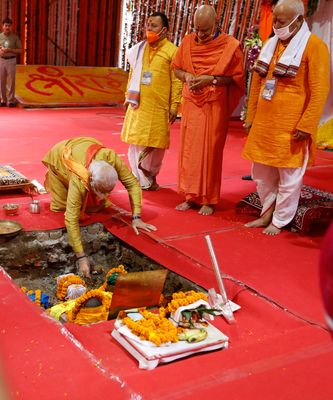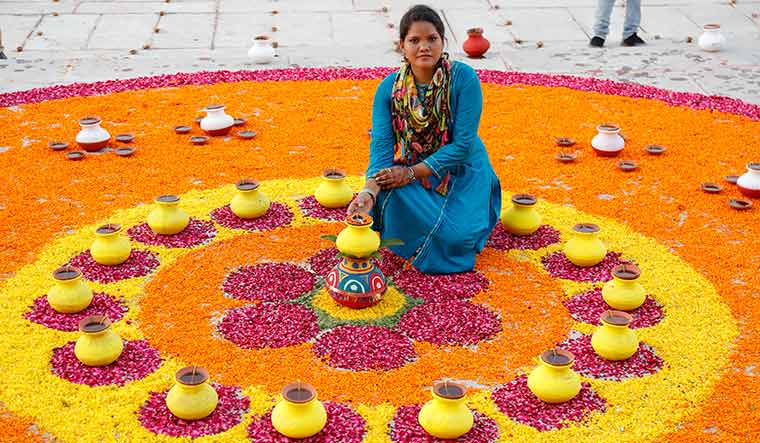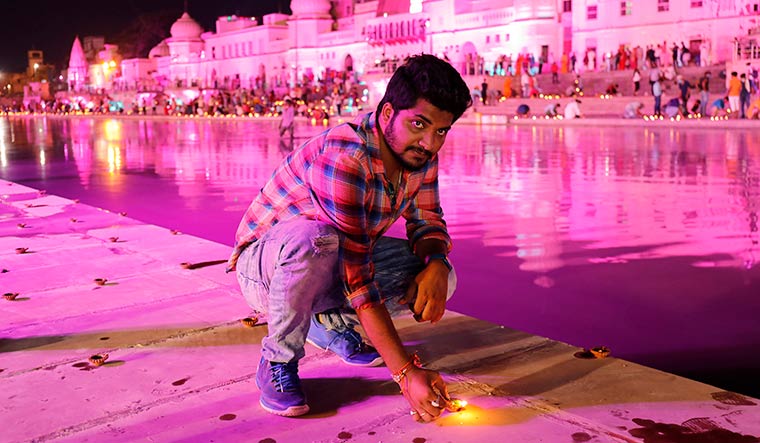Part resilient, part frail—faith is a strange being. It is also a magical being, and it must be poured into the foundation of the proposed Ram Mandir, for it to be the embodiment of the many symbols that would lie beneath its promised grandeur. These symbols have shaped politics, society and culture in myriad ways. To burnish them, the temple needs to be invested with the faith of a generation that was not born when the mandir movement began gaining momentum.
In Uttar Pradesh, one in four voters is aged between 18 and 29 years. It is a generation that does not have tangible memories of the most visible flashpoints of the movement—the firing on kar sevaks in 1990 and the demolition of Babri Masjid in 1992. It is a generation that did not gape at television screens as the domes came down. It did not hear the bloodied calls that exhorted the faithful to step out in service of Lord Ram. It did not weep over the deaths that followed, and it did not live through the dark fear of those days.
This generation will only grow bigger. For those who belong to it, the movement and its symbols are stories bequeathed—often embellished or toned down depending on the narrator’s convictions.
Deepa Singh Raghuvanshi, 28, heard her stories from those who were intimately involved in the movement. A folk artiste in Ayodhya, Raghuvanshi was six months old when the masjid was demolished. Her home is close to the Ram Janambhoomi Nyas Karyashala, the workshop where columns for the temple are carved. The workshop was set up the year she was born. So for her whole life, Raghuvanshi has had a ringside view of the tasks that went on quietly and persistently even when the mandir seemed a mirage.
She has also seen the unbridled devotion of visitors who prostrate before the pillars, as if they were in the presence of Ram himself. “Since childhood, I have spent hours in the karyashala,” said Raghuvanshi. “I have heard many stories from artisans. The hopes and pains of those who chiselled these stones have seeped into me. Many who worked in those initial years are gone, but today I feel as though I bear their happiness as well.”
Would she then vote for the political party that claims credit for that happiness? She thought for minutes and said, “There are other important qualities one looks for in leaders. The Ram Mandir will be at the back of my mind, though.”
Arun Kumar Choubey, 33, state convenor of the Akhil Bharatiya Vidyarthi Parishad, said there was no need to drill Ram and hindutva into the youth, because there was already an “innate” bond. “We grew up listening to the stories,” said Choubey. “No picture or book is necessary to foster that connection. The bhumi pujan (stone-laying ceremony), however, is a great opportunity to reinforce our core messaging. We don’t look at it as a chance for the organisation to grow, but as a chance to do more in service of the nation.”
The Viswa Hindu Parishad, which spearheaded the mandir movement, is not leaving anything to chance, though. It has tasked itself with a massive youth connect programme to ensure that the relationship goes beyond social media campaigns, which are often amorphous and simplistic and do not yield movements in the real world. One example: The hashtag #ProfileForRam, which gained popularity on the night of August 4. Users were asked to change their display pictures or post their favourite picture of Ram. In the accompanying messages, some shared stories of family members performing kar seva; others asked when these relatives were returning and how they could join in.
The kar seva in Ayodhya is not a continuous process, of course. No fresh calls have been made. And the seva is not as simple as getting to the town, helping around, taking a few pictures and leaving.
Mahendra Pathak, associate professor in the department of ancient history at K.S. Saket Postgraduate College in Ayodhya, was a postgraduate student when the movement began to intensify. In 1986, when the main entrance to the site was unlocked, Pathak felt a “distinct excitement”. In 1990, when hundreds of kar sevaks were arrested, he walked out of his home, clutching the hand of his five-year-old son, to give himself up to the police in protest.
“This sense of service was not born in a day,” said Pathak. “I became an RSS member when I was seven and was studying in a missionary school. My devotion is to the dhwaj (the saffron RSS flag) and the values it represents. The dhwaj is consistent. So is my devotion. The youth of today are different. Their first question would be: ‘What is in it for me?’ That is not an emotion that drives movements.”
Rohit Pal, 24, a student of tourism and hospitality at Dr Rammanohar Lohia Avadh University, has a deep emotional connection with Ayodhya. His social media page is filled with pictures and stories about the town of winding lanes and countless temples. “I cannot imagine myself living elsewhere,” said Pal.
He is, however, unsure about whether he can call himself an Ayodhyawasi (resident of Ayodhya); according to his postal address, he said, he lives in Faizabad. Interestingly, Pal seemed oblivious to the fact that the Uttar Pradesh government had renamed Faizabad district as Ayodhya in 2018. The memory lapse may be a minor detail, but it holds a mirror to the amorphous nature of the bonds that Pal and his peers have with Ayodhya.
Pal’s political preferences are tied to development. “I want to make a career as a photographer and storyteller of Ayodhya,” he said. “All that needs to be done to develop the tourism sector must be done soon.”
Shikhar Kapoor, 25, is the director of one of the oldest hotels in Ayodhya. It is a family property. A graduate in hospitality management, Kapoor was offered a job after he completed the course. “I was in a dilemma, but I chose the safe way,” he says.
That safe way was the absence of competition in Ayodhya and the relative ease of work. With the government’s focus on developing the area as a pilgrimage circuit—complete with an international airport—that perceived ease has vanished. Yet, Kapoor says he is so immersed in Ayodhya’s pace of life that he would be a misfit elsewhere.
“I would never consider getting involved in any movement. It is all too easy to identify troublemakers now. I keep my head down and work. I do not want any jhamela (nuisance),” said Kapoor, who last visited the temple site when he was in school.
Will the grand bhumi pujan capture the imagination and faith of youth like Kapoor and thereby yield political dividends? Ajit Kumar Pandey, professor of sociology at Banaras Hindu University, believes that it has the potential to draw the youth away from the values enshrined in the Constitution.
“Think of the state as an elder. It is from this elder that the young draw their examples and inspiration,” he said. “The [title suit] has been resolved—rightly or wrongly. A mature, peaceful state need not make propaganda out of it. This is not in consonance with democratic values, and is likely to influence young minds into thinking that such displays by the state should be acceptable.”
But faith—that wavering being—does not always accede to logic. That is its charm and challenge.




